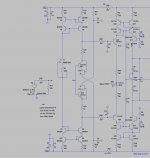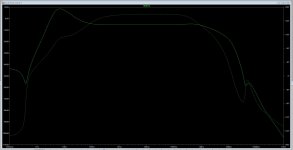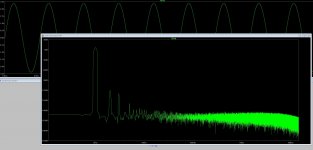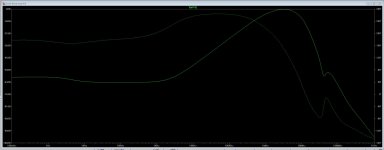Of course, you are right... on the paper.Esperado, I belivee that CFA-s can have as good PSSR numbers as any VFA, it's just a matter of making sure that gain-componets are shielded by CCS, also currents can be mirrors to the VAS stage, that will increase PSSR and also increase openloop gain and lower distortion figures.
The problem is all the complexity you can add in a CFA (cascodes, diamonds or super pairs, CCS etc. have a direct influence on the open loop phases at HF and slew rate. I believe this is not the best way to go with a CFA.
Same remark about open loop gain. We have to find a compromise between gain and FT. I believe it is better to look for an extended bandwidth at HF , for a constant feedback ratio at least up to 10 KHz in CFAs.
Better, OMHO, fight for speed, stability, and accept decent but no overkill PSSR and HD.
And chose, (just my opinion again), VFAs or Class D where speed is not a matter, but distortions are the goal (low frequencies).
To give an image, to chose a limousine when you have long travels to do (fight for comfort designing them) and formula ones for races (fight for acceleration, speed and handling).
Last edited:
Even with this you have more than 80 degrees phase-margin (tian probe) But true the gain margin suffers a bit when you increase the gain. here its around 24 dB.
I look at it as separating voltage swing from current swing and optimizing circuit's impedance's to accomplish that. The improved PSSR is just an extra benefit.
I look at it as separating voltage swing from current swing and optimizing circuit's impedance's to accomplish that. The improved PSSR is just an extra benefit.

Attachments
To Magicbox, some guy took an engineering approach to describing what we hear in playback and PRAT was separate from timbral accuracy. To Bonsai, from what I understood from those posts, he defines timbral accuracy as the accuracy in the reproduction of the recorded waveform. His argument was that a clean square wave is not sufficiently reliable to predict good sound reproduction because the music waveform has too many simultaneous frequencies with various levels when compared to the single tones most of us use to test. You can read about it here and here. There is a lot of rubbish in there but to me, it didn't sound like most of it came from the original poster. As circuits get faster, the grounding schemes and layout become more and more important than the feedback. Simulations are great when roughing up a circuit but they have serious limitations predicting the field effects of the components on the board. The CFA vs. VFA rumble thread offers some great insights on a similar design with these different feedback schemes.
Last edited:
Q22 collector loopgain (with 1GH coil in Feedback)
Distortion, just can't complain too much about the profile:
N-Period=1
Fourier components of V(out)
DC component:5.46251e-006
Harmonic Frequency Fourier Normalized Phase Normalized
Number [Hz] Component Component [degree] Phase [deg]
1 1.000e+03 3.339e+00 1.000e+00 -0.16° 0.00°
2 2.000e+03 1.347e-06 4.033e-07 -2.07° -1.91°
3 3.000e+03 4.862e-07 1.456e-07 89.13° 89.29°
4 4.000e+03 3.143e-10 9.414e-11 -173.34° -173.19°
5 5.000e+03 1.595e-08 4.778e-09 91.23° 91.38°
6 6.000e+03 1.264e-09 3.785e-10 46.82° 46.98°
7 7.000e+03 2.874e-09 8.608e-10 -128.96° -128.80°
8 8.000e+03 4.039e-09 1.210e-09 -51.38° -51.23°
9 9.000e+03 8.741e-10 2.618e-10 111.39° 111.54°
Total Harmonic Distortion: 0.000043%
Distortion, just can't complain too much about the profile:
N-Period=1
Fourier components of V(out)
DC component:5.46251e-006
Harmonic Frequency Fourier Normalized Phase Normalized
Number [Hz] Component Component [degree] Phase [deg]
1 1.000e+03 3.339e+00 1.000e+00 -0.16° 0.00°
2 2.000e+03 1.347e-06 4.033e-07 -2.07° -1.91°
3 3.000e+03 4.862e-07 1.456e-07 89.13° 89.29°
4 4.000e+03 3.143e-10 9.414e-11 -173.34° -173.19°
5 5.000e+03 1.595e-08 4.778e-09 91.23° 91.38°
6 6.000e+03 1.264e-09 3.785e-10 46.82° 46.98°
7 7.000e+03 2.874e-09 8.608e-10 -128.96° -128.80°
8 8.000e+03 4.039e-09 1.210e-09 -51.38° -51.23°
9 9.000e+03 8.741e-10 2.618e-10 111.39° 111.54°
Total Harmonic Distortion: 0.000043%
Attachments
MIIB, i don't understand your graph. I asked for an AC analysis at Q22 collector (input of the VAS). Closed loop.
I will show something like:

I will show something like:

Last edited:
So, you can see the FC is around 2.3KHz on your, while it is 10KHz on mine.
It makes a huge difference and that demonstrate what i was talking about. ;-)
I believe than, despite higher distortion numbers, well above audibility threshold anyway, my graph has a luck to offer more coherency in the sound stage. And that, when we are about CFAs, simple is beautiful is the way.
Of course, it is just *my* opinion, based on *my* experiences, you have to make your own by listening both trials.
I think CFA requires a very different approach, not usual for VFA designers and i'm curious to see the listening reports of OS's CFA designs.
He designed his CFAs versions in a very VFA way to think.
It makes a huge difference and that demonstrate what i was talking about. ;-)
I believe than, despite higher distortion numbers, well above audibility threshold anyway, my graph has a luck to offer more coherency in the sound stage. And that, when we are about CFAs, simple is beautiful is the way.
Of course, it is just *my* opinion, based on *my* experiences, you have to make your own by listening both trials.
I think CFA requires a very different approach, not usual for VFA designers and i'm curious to see the listening reports of OS's CFA designs.
He designed his CFAs versions in a very VFA way to think.
Last edited:
Not understood, loop-gain and feedback ratio sets the distortion,
This curve can be shaped most anyway you desire, it's not a reflection of the mirrors VS simple resistors. here the curve again, mirrors maintained VAS cascode removed. Now this is a trade-off, as the VAS cascode offers 20 dB better 20KHz distortion figures when you push the amplifier as well as 10 degrees better phase-margin, take your choices. here the corner is about 20 KHz does that make it twice as good as yours..??
I too love the simple circuits, but simple may require a better framework to perform, one clear benefit of my approach is that you can make the thermals a non issue.
This curve can be shaped most anyway you desire, it's not a reflection of the mirrors VS simple resistors. here the curve again, mirrors maintained VAS cascode removed. Now this is a trade-off, as the VAS cascode offers 20 dB better 20KHz distortion figures when you push the amplifier as well as 10 degrees better phase-margin, take your choices. here the corner is about 20 KHz does that make it twice as good as yours..??
I too love the simple circuits, but simple may require a better framework to perform, one clear benefit of my approach is that you can make the thermals a non issue.
Attachments
Last edited:
What is the correlation to insure greater sound stage coherency? In other words, what electrical attribute or measurement repeatably increases it?
Much more better, on my opinion. It will be easy for you to figure out witch one will give-you the best listening results.
We cannot discuss about the correlation of each measured (or worse, simulated) numbers, and what we hear in real life. Nobody has determined thresholds in a definitive way.
We cannot discuss about the correlation of each measured (or worse, simulated) numbers, and what we hear in real life. Nobody has determined thresholds in a definitive way.
Linearity of the feedback ratio all along the bandwidth we can hear. (In between other things, correlated, like phase linearity).What is the correlation to insure greater sound stage coherency?
And some other things, that we usually don't measure, concerning TIM, FM distortions etc... correlated with Slew rates: Music is made of transients.
Last edited:
MiiB, i know my positions can look a little strange, sometimes. When i began my career, i was a very deep believer in measurements, objectivity, science like a religion. And we had no simulation tools ;-)
I made my mind by experiences in real world, chasing the evils, relying more and more on my feelings and listening tests than on measurements, that i use, now, only to prove myself i'm driving in the right direction.
I'm not alone in this evolution and can work as a cop of the Forensic Services to find the guilty and the mobiles;-). Relying sometimes on feelings don't imply we are snake oil sellers, i hate them. I try to understand and correlate with all the inputs and tools i can have.
In this cascode issue, my first reflex (and the same for each and every add to the basic topology), would be to listen to both choices, try to improve the evils of this cascode (make-it faster ?) and figure out.
What will be better, playing various music samples, speed or distortion ?
Now, sometimes, we had to choose something witch do not go in the direction we prefer, like attempting best numbers for the marketing department if it helps the sells ;-)
You will tell-us what you'll found in real life, and your point of view will help everybody to have a good sight at the whole landscape and save time for future decisions, as i tried here..
I made my mind by experiences in real world, chasing the evils, relying more and more on my feelings and listening tests than on measurements, that i use, now, only to prove myself i'm driving in the right direction.
I'm not alone in this evolution and can work as a cop of the Forensic Services to find the guilty and the mobiles;-). Relying sometimes on feelings don't imply we are snake oil sellers, i hate them. I try to understand and correlate with all the inputs and tools i can have.
In this cascode issue, my first reflex (and the same for each and every add to the basic topology), would be to listen to both choices, try to improve the evils of this cascode (make-it faster ?) and figure out.
What will be better, playing various music samples, speed or distortion ?
Now, sometimes, we had to choose something witch do not go in the direction we prefer, like attempting best numbers for the marketing department if it helps the sells ;-)
You will tell-us what you'll found in real life, and your point of view will help everybody to have a good sight at the whole landscape and save time for future decisions, as i tried here..
Last edited:
Thanks, those are things worth investigating. I agree with your caution about using sims alone. I've been burned once too many times relying upon them without building. How important is amp phase margin to the sound we hear in the room? What I mean is, can we hear a difference between a 75 and 90 degree phase margin if both are rock stable through the bandwidth?
I am not a believer in numbers and i don't believe that better measurements or simulations automatically leads to better music.
I design speakers and work in a field where what you measure should reflect how we understand and interpret elements. in speaker design SPL linearity is perhaps the most misunderstood design goal of them all.
If you make a speaker linear then all you hear are the crossover regions, a two way monitor will sound bright and in you face, if you don't recess the X-over region a small magnitude. now this is quite understandable as you have two drivers trying to play the same which is impossible as they have different masses, rise-time and noise content. this will trigger our alert tool and tell us something is very wrong. by making a small suck-out you can make the ears more at ease.
Same with amplifiers, we really don't know what holds the quality, distortion can't be a main factor, maybe PSU, stability and good practice around grounding is a much better ques.
I design speakers and work in a field where what you measure should reflect how we understand and interpret elements. in speaker design SPL linearity is perhaps the most misunderstood design goal of them all.
If you make a speaker linear then all you hear are the crossover regions, a two way monitor will sound bright and in you face, if you don't recess the X-over region a small magnitude. now this is quite understandable as you have two drivers trying to play the same which is impossible as they have different masses, rise-time and noise content. this will trigger our alert tool and tell us something is very wrong. by making a small suck-out you can make the ears more at ease.
Same with amplifiers, we really don't know what holds the quality, distortion can't be a main factor, maybe PSU, stability and good practice around grounding is a much better ques.
Numbers are important for comparison but knowing which ones matter the most seems to be paramount. The "Sound Quality versus Measurements" thread has discussions on this topic but there is a lot of off-topic and time wasting there. The threads I linked above are a little more focused on this topic. I think most people know about the symbiotic relationship of amps and speakers but there are fewer variables to control in the amp so we should try to make this the standard by making it as free from distortion as possible. The problem is identifying which distortions to favor in our compromises.
If you make a speaker linear then all you hear are the crossover regions, a two way monitor will sound bright and in you face, if you don't recess the X-over region a small magnitude. now this is quite understandable as you have two drivers trying to play the same which is impossible as they have different masses, rise-time and noise content. this will trigger our alert tool and tell us something is very wrong. by making a small suck-out you can make the ears more at ease.
I disagree here, MiiB. I think your conclusion is based on working with brittle high distortion cones (woofer @ crossover frequency) which lead you with the need to pad the crossover region down.
My main reason for disagreement is that even a slight bump at crossover frequency can be listenable when correct (transient perfect) so I cannot see a reason not to strive for flat response for correct timbre.
jay- good luck.
I have base/mid drivers with a first fundamental breakup above 20KHz, (use to 3.5 KHz) maybe the least noisy drivers the world has ever seen, and yet I totally stad behind what i say. Now this is not a loudspeaker debat so this is th last I'll say about that...
I have base/mid drivers with a first fundamental breakup above 20KHz, (use to 3.5 KHz) maybe the least noisy drivers the world has ever seen, and yet I totally stad behind what i say. Now this is not a loudspeaker debat so this is th last I'll say about that...
Last edited:
Crossover distortions, amp or speaker, might be the most pernicious of all the types to the naturalness of sound so I completely understand the logic of MiiB's method but that said, I'd rather avoid trying a custom response curve on an amp. When I test an amp, it's usually on a full range driver so as to eliminate as many of the loudspeaker variables as possible.
No an amp has to be straight, this is beyond any doubt. But when making the '"electric signal to hearing# interface you have to look at the ingredients you have to cook together, speakers are much more of a compromise than any other part of the chain, as you have to juggle highly complex and unlinear things like air, dispersion and human hearing. this you have to understand in order to set direction and make choices.
Last edited:
- Home
- Amplifiers
- Solid State
- CFA Topology Audio Amplifiers




